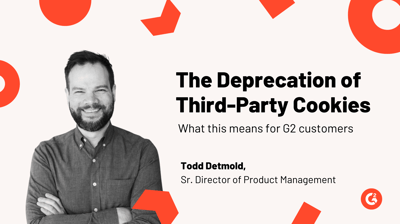February 7, 2024
 by Bikash Thokchom / February 7, 2024
by Bikash Thokchom / February 7, 2024

Marketers today rely on data-driven approaches to engage prospects.
You yourself may have found that more and more marketers are using intent data to enhance the targeted nature of account-based marketing (ABM) initiatives.
This type of information has been able to capture the imagination of sales and marketing alike when it comes to identifying in-market buyers. And since account-based marketing is a leading B2B program, it’s worth exploring how to apply intent data in this field.
Before we jump into the use cases of intent data in ABM, let’s make sure we’re on the same page about what intent data means. Most companies and marketers refer to third-party intent data as B2B intent data.
However, that’s not the complete definition.
On a broad level, intent data refers to all the signals that result from engaging potential buyers with your website or marketing communications across channels, as well as the research your future customers do on their own. Intent data helps you understand where your buyers are on their journey.
The value of intent data is derived from the fact that buyers spend the majority of their time in independent research online. This leads to an undeniable need to catch these signals and apply them to marketing initiatives, although their use and benefits vary depending on the type.
Depending on the source, intent data is categorized into three types: first-party, second-party, and third-party intent data.
First-party intent data or engagement data are signals captured from your own website, paid landing pages, email campaigns, and your other digital properties.
Second-party intent data is collected by a provider on their platform through registrations and user activity tracking. The intent data provider then collates the signals and anonymizes them to prevent privacy breaches.
B2B intent data or third-party intent data is aggregated by a provider that has no direct relationship with the company.
These signals represent the behavior of buyers who are researching solutions similar to yours without having yet visited your website or even knowing about your solution. These third-party vendors usually partner with several ad networks, digital publishing houses, and organizations where this info can be sourced.
While this data serves as breadcrumbs on the buyer’s journey, it requires more processing before you can start using it. In the rest of the article, we’ll focus on this type of intent data.
Today, most organizations either focus on their own intent data or use intent data sourced from providers. Even for ABM programs, there’s either a heavy focus on generating first-party engagements or a direct application of third-party intent data.
This single-minded data usage limits marketers from surfacing critical buyer insights. A comprehensive blend of all three types of data can give you and your team a clear understanding of your customer’s journey by capturing their perspectives at all stages.
Case in point: G2's Buyer Intent Data helps marketing, sales, and customer success teams get crucial intel to reach the right audience at the right time - every time.
The use of intent data has grown from mere prospecting to impacting the full lifecycle of target accounts.
In this time of tight marketing budgets, intent data gives you a precise, exacting approach. Activating marketing and sales outreach efforts exclusively for active buyers can reduce costs by increasing efficiency.
Intent data users across experience levels have reported its advantages. Many organizations, including the most advanced adopters of intent data, have explored only a few simple use cases, but this marketing tack has vast, unexplored potential.
The majority of B2B marketers use intent data within their ABM programs, which has made it easier for marketers to understand the buying intent surge for their target accounts.
While the most common use cases of intent data in ABM programs are in identifying accounts for SDR outreach, many marketers are coming up with more creative uses.
Whether it’s pointing out churn signals in existing accounts or requirements of other solutions in your portfolio, ABM marketers are applying intent data strength to the entire customer lifecycle and the full gamut of marketing motions.
The first and foremost use of intent data for ABM is identifying accounts that are looking to buy.
Just having accurate intelligence on interested accounts can get you miles ahead of the competition. No wonder most marketers depend on intent data to get their ABM engine started.
ABM is all about sharpening your focus on accounts, and there’s no better way to do it than with an accurate account scoring and prioritization model. Using intent data, marketers light up the funnel to understand the buyer’s journey and identify the relevant buying stages.
ABM marketers and solution providers have started innovating ways to fit buyer intent into scoring programs. The intensity of the signals helps them arrive at scores that can be used to prioritize accounts for marketing and sales outreach.
ABM, by definition, is about running after a named list of accounts.
However, meeting revenue goals or driving predictable growth with only a handful of accounts can become hard. Intent data could be your savior in a scenario like this. By identifying look-alike accounts of your existing customers that are showing high intent, you can expand your ABM list.
Orchestrating a B2B buyer’s journey is long and tedious. You can rely on intent data to weed out the accounts that are less likely to buy from you.
Marketers can identify the high-value accounts that are researching your solutions and focus on them. You can even craft contextual conversations around the intent data.
Wouldn’t it be great if you could identify which of your existing accounts are researching your other products or services? Intent data helps you do just that by telling you which intent topics your customers are actively looking at.
Aggregating this data and clubbing it with your engagement data reveals insights to help you create more sales opportunities.
There’s no doubt that intent data fuels your ABM program with insights for account-level personalization. But it takes this personalization to another level.
With context for conversation available through the intent topics and keywords, marketers have the advantage of personalizing every campaign and outreach message through intent data.
Read more: Elevating ABM with Buying Group Marketing →
Third-party intent data is usually sourced raw. You have to ensure that your search is limited to topics or keywords relevant to your business.
If you offer multiple products, then there has to be even more focus on making the intent keyword specific. If you skip this step, your ABM program will be drowned out by noise.
Let’s look at a few more challenges you might have to overcome with this new process.
Intent data is always available as anonymized data at an account level. To move high-intent accounts down the funnel and shorten the sales cycle, you need to understand the buyer group personas. This is where most marketers hit the wall.
While marketers can always target the whole account, the effort and time investment is going to be huge. To make your ABM program more effective and scalable, invest in targeted marketing efforts.
Marketers must learn to deal with the possibility of false positives. False positives come in when organizations target broad categories of intent signals.
Not only should the intent topics be focused on precise business topics, but you also have to remember that intent data is just one piece of the puzzle. Organizations must come up with their own processes to refine intent signals sourced from third-party vendors.
As intent data is largely an indicator of research, there is no guarantee that all high-intent accounts will become your prospects.
The need to have a clear definition of your target account ICP becomes so much more important in such a situation.
If used unchecked, intent data leads you to burn up your critical resources on ineffective marketing and sales efforts. With third-party intent data becoming a potent signal for SDRs, there’s always a risk of overreliance.
If your intent signals are inaccurately sourced, they could be chasing the wrong accounts. Remember that intent data is just one way to find qualifying accounts.
Intent data may make it look like a customer is ready to make a purchase, but that’s not always the case. Each of your potential accounts has numerous reasons to actively research topics related to your solution.
Concealing identity at the contact level means we have no clue about the researcher’s persona.
Intent data only helps you sharpen your ABM program if you contextualize it to your business. You can close the gaps that open from using unfiltered, unprocessed data by aligning your signals with your ICP.
Work on developing stronger intent strategies to face the execution challenges. Here are some of the ways you and your marketers can look at refining your ABM initiatives.
All the B2B intent data you source from your provider must focus on topics relevant to your solution. Identifying business-critical subjects and keywords is an exercise you should conduct as soon as you decide to go the third-party route.
Maybe you won’t have the perfect set of keywords as soon as you start, but you have to begin the process.
Your vendor may only give you raw data, or they may help you with processed data. In either case, it helps to have your own system or process of filtering intent signals based on your important phrases. This makes your intent-based program more targeted.
You may have dozens of keywords or topics that you deem relevant. However, not all these topics have the same levels of significance. You start by grouping your topics into different categories according to their levels of importance and score each category differently.
A scoring mechanism like this helps you make your incoming intent signals more aligned with your ICP.
This is just one of the basic ways to make intent data more ICP relevant. You can always build more advanced and stronger systems for your data or use a software platform that does it for you.
Most organizations and marketers rely on either their first-party data or third-party, while ignoring other data sets. Some swear by their engagement data, and some just find it easier to apply third-party findings to their ABM execution.
What most don’t realize is the power of their combined strength. You can use engagement data to validate intent data and vice versa.
Individually, neither of them are true indicators of buying intent, but a mix of the two provides you with enough intent strength to understand the buyer’s journey. This helps you qualify the right accounts for marketing and SDR activities.
For accounts that show high intent, your engagement signals could be a great verifier of whether they’re actively in-market. Sometimes, you might have high-intent accounts that are only in the problem-aware state and need more nudges to learn about your solutions.
You can better understand their buying journey through signals from eclectic marketing activities. Once the buying stage is identified, that’s when you trigger the next steps.
Doing it this way means you won’t just push all accounts with high intent to SDR outreach. It also ensures that you don’t neglect accounts without much data.
At the outset, using B2B intent data seems like an easy process, but simply sourcing files of data and using them as they come isn’t going to result in the ABM effectiveness you want.
You need technology that effectively brings in all types of data from your marketing, sales, and customer success teams to surface buyer journey insights that build solid, trusting relationships with your audience.
Once you find a platform of such caliber, you can harness the power of your intent data across the entire lifecycle to support full ABM capabilities.
Ready to supercharge your sales strategy? Here are 5 tips to crush your intent data goals.
Edited by Aisha West
Bikash is a revenue-focused marketer with over 8 years of experience across B2B and B2C. From e-commerce to B2B Saas, he has honed his marketing acumen across brand and revenue marketing. When he’s not busy telling the world about BambooBox, he loves to cook and binge watch TV shows.
We’re all familiar with the story of Goldilocks, right?
 by Andy Golden
by Andy Golden
It’s no secret that B2B marketing teams are being held accountable for their influence on the...
 by Ranga Kaliyur
by Ranga Kaliyur
For several years now, marketers and technology vendors alike have been preparing for the ...
 by Todd Detmold
by Todd Detmold
We’re all familiar with the story of Goldilocks, right?
 by Andy Golden
by Andy Golden
It’s no secret that B2B marketing teams are being held accountable for their influence on the...
 by Ranga Kaliyur
by Ranga Kaliyur


